Uruguay are the joint-most successful team in Copa América history, joint at the top of the all-time winners rankings with Argentina on 15 titles apiece.
However, they’ve failed to make it past the quarter-finals in any of the last four iterations of this tournament, dropping out at that stage in 2015, 2019 and 2021, while they exited in the group stage in 2016 — an even greater catastrophe for the football-mad nation.
They enter the 2024 edition revitalised under legendary manager Marcelo Bielsa, boasting a relatively young squad with some fresh legs and fresh ideas in the squad now compared to 2021, and this tactical analysis piece will provide a team-focused scout report detailing the tactics and providing analysis of what to expect from Bielsa’s side in this summer’s showcase of the Americas’ greatest footballing talent.
So, let’s get into our analysis of a team that will have high hopes of bettering their recent Copa América performances in this year’s competition.
Predicted Starting XI
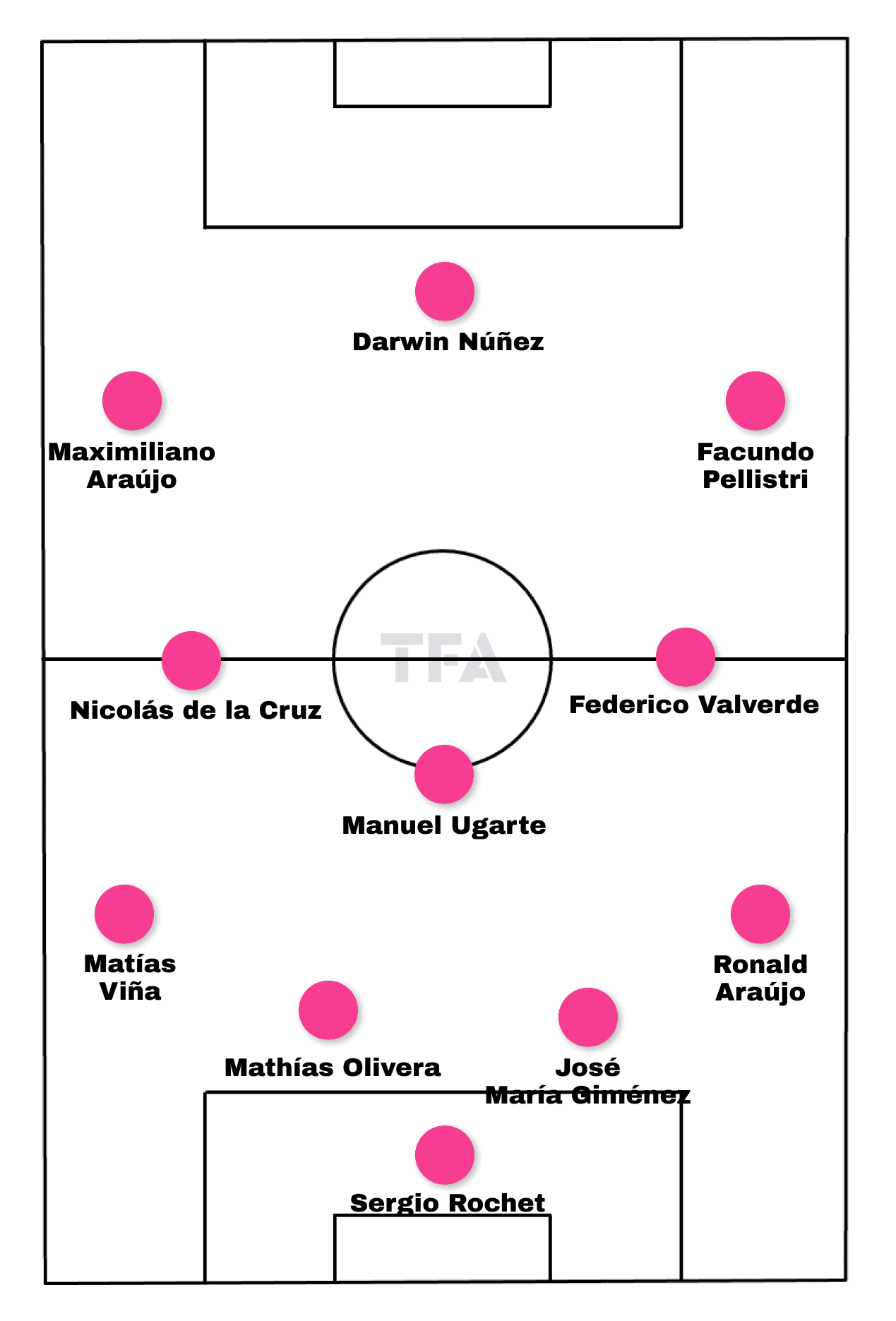
As figure 1 indicates, we anticipate Uruguay primarily lining up in a 4-3-3 shape in this summer’s Copa América, though their midfield shape will vary depending on the opposition, with the team taking quite a man-oriented approach without the ball, especially in those central areas.
We foresee Sergio Rochet of Brazilian side Internacional starting in goal behind a backline consisting of Barcelona’s Ronaldo Araújo — who we’re slotting in at right-back but could also feature in the centre of defence — alongside Atlético Madrid’s José María Giménez, Napoli’s Mathías Olivera — a left-back who can also play at left centre-back, and we predict will occupy that position to provide the in-possession balance that Bielsa would want, having played in this position for his country in recent games — while Flamengo’s Matías Viña starts on the left of defence for us.
We’re fairly confident that our midfield selections—Manuel Ugarte at the base alongside Nicolás de la Cruz to his left and Federico Valverde to his right—will feature for Uruguay in this tournament.
This particular trio has played quite consistently for their nation in recent times.
We predict 24-year-old Maximiliano Araújo starts on the left with 22-year-old Facundo Pellistri on the right, both on either side of 24-year-old Darwin Núñez at centre-forward.
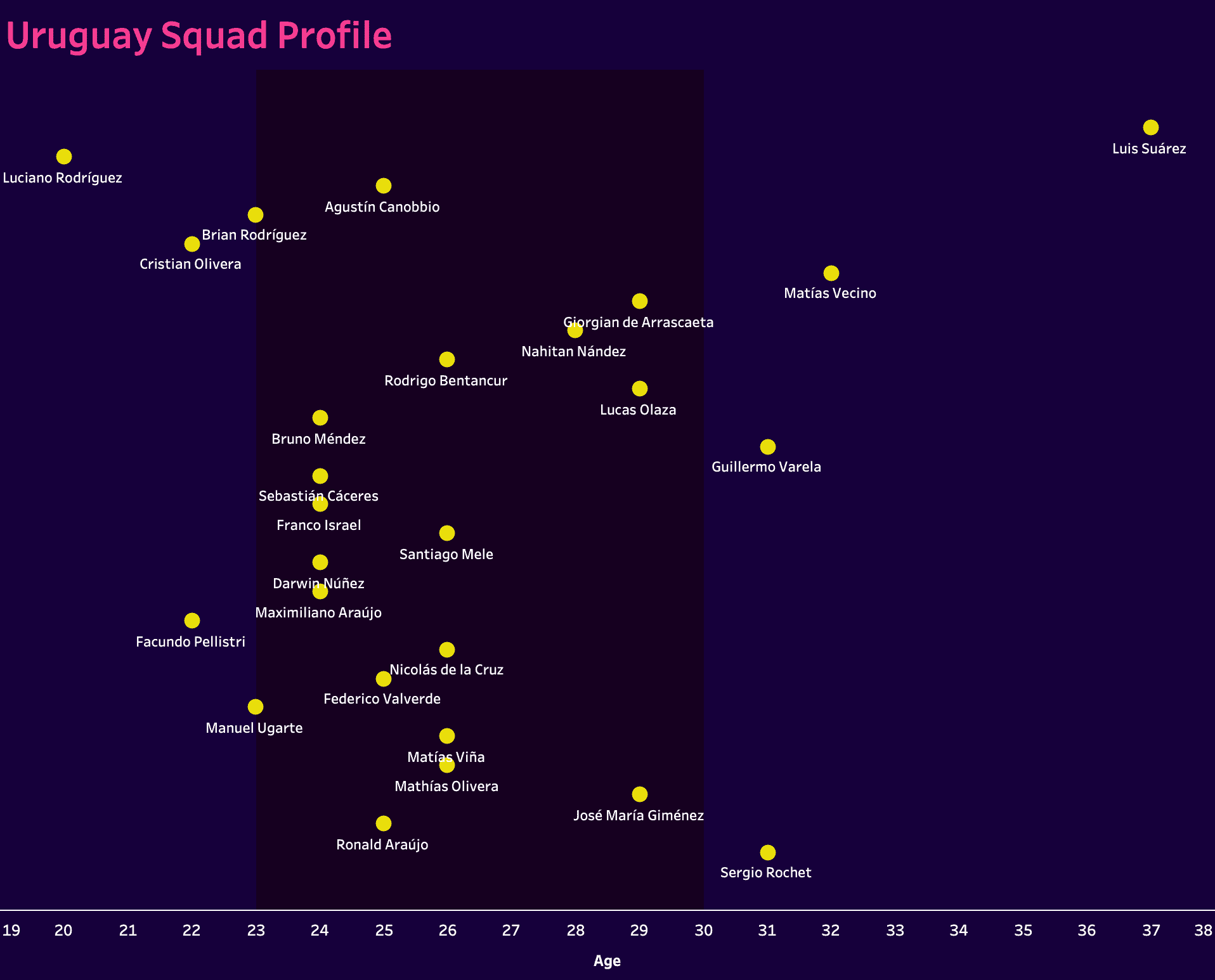
This starting XI features a 22-year-old (Pellistri), a 23-year-old (Ugarte) and two 24-year-olds (Núñez and Maximiliano Araújo), while no outfield player is in their 30s, with goalkeeper Rochet (31 years old) being the oldest member of the team — still, not particularly old by goalkeeping standards, emphasising the youthful nature of Bielsa’s team.
In figure 2, we see the age distribution of our predicted Uruguay squad for the tournament, with four of our predicted squad falling in the 30+ ‘experienced player’ bracket, including Uruguay legend Luis Suárez, whose experience could prove a valuable asset to the young squad should he join up with his compatriots for the tournament as we predict.
The majority of our predicted squad falls in the youth-to-early-prime years, as indicated by the above data viz.
Attacking phase
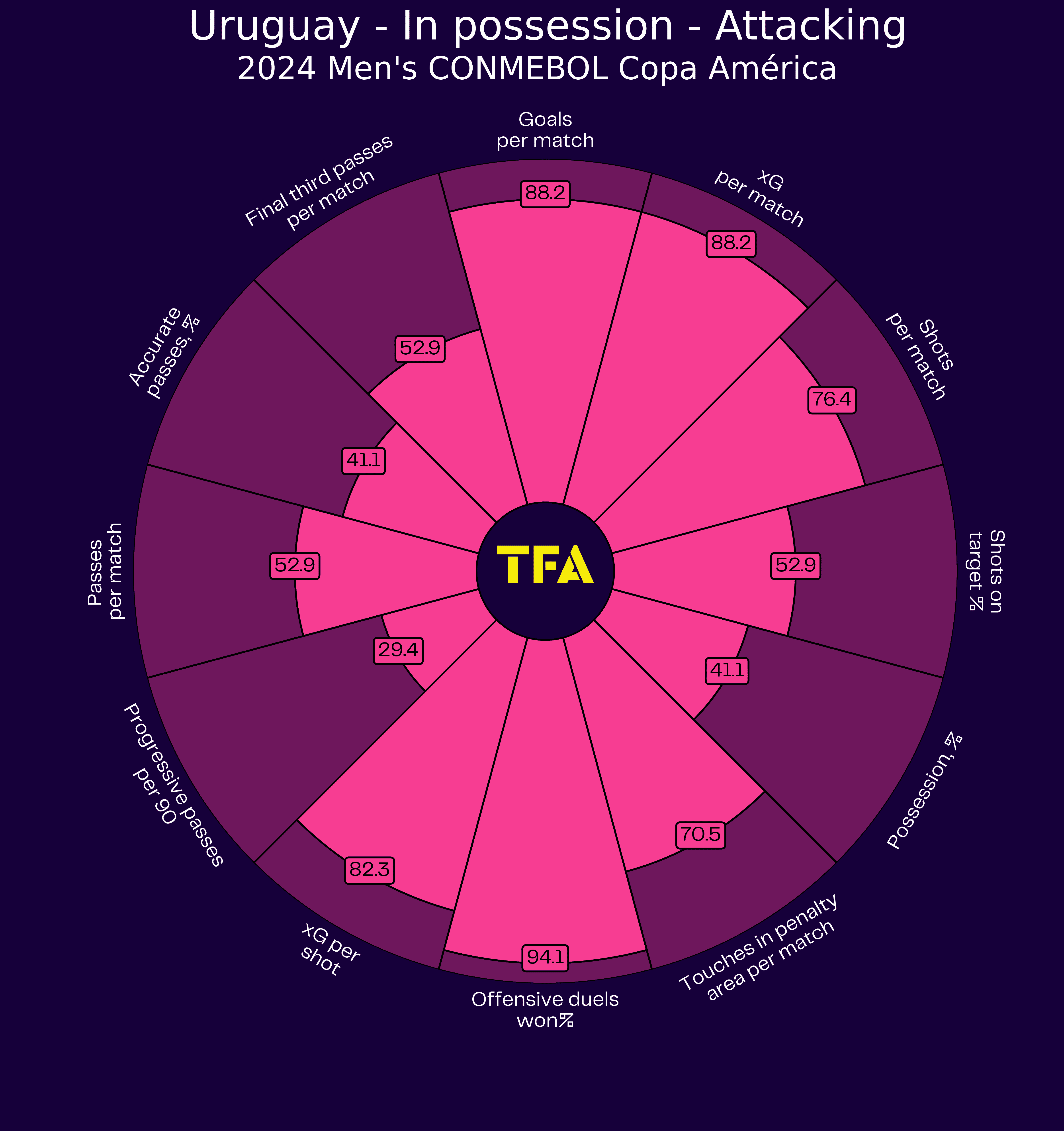
A Bielsa team will always provide plenty worth analysing from a tactical perspective, both in and out of possession, as well as in transitions.
We’ll touch on what you can expect from Uruguay in all of those distinctive phases in this tactical analysis, beginning with their attacking phases in this section.
Firstly, looking at the pizza chart in figure 3, which uses data from Uruguay’s games in all competitions over the last calendar year and compares it with data from their 2024 Copa América foes from the same time period, we can clearly observe that Uruguay have been relatively fruitful in attack, falling in the 88th percentile for both goals per 90 and xG per 90, along with the 76th percentile for shots per 90.
This isn’t a heavily possession-dominant side but they are a highly creative side who’ve proven potent in breaking their opponents down repeatedly over the last calendar year — making excellent use of the possession they have kept.
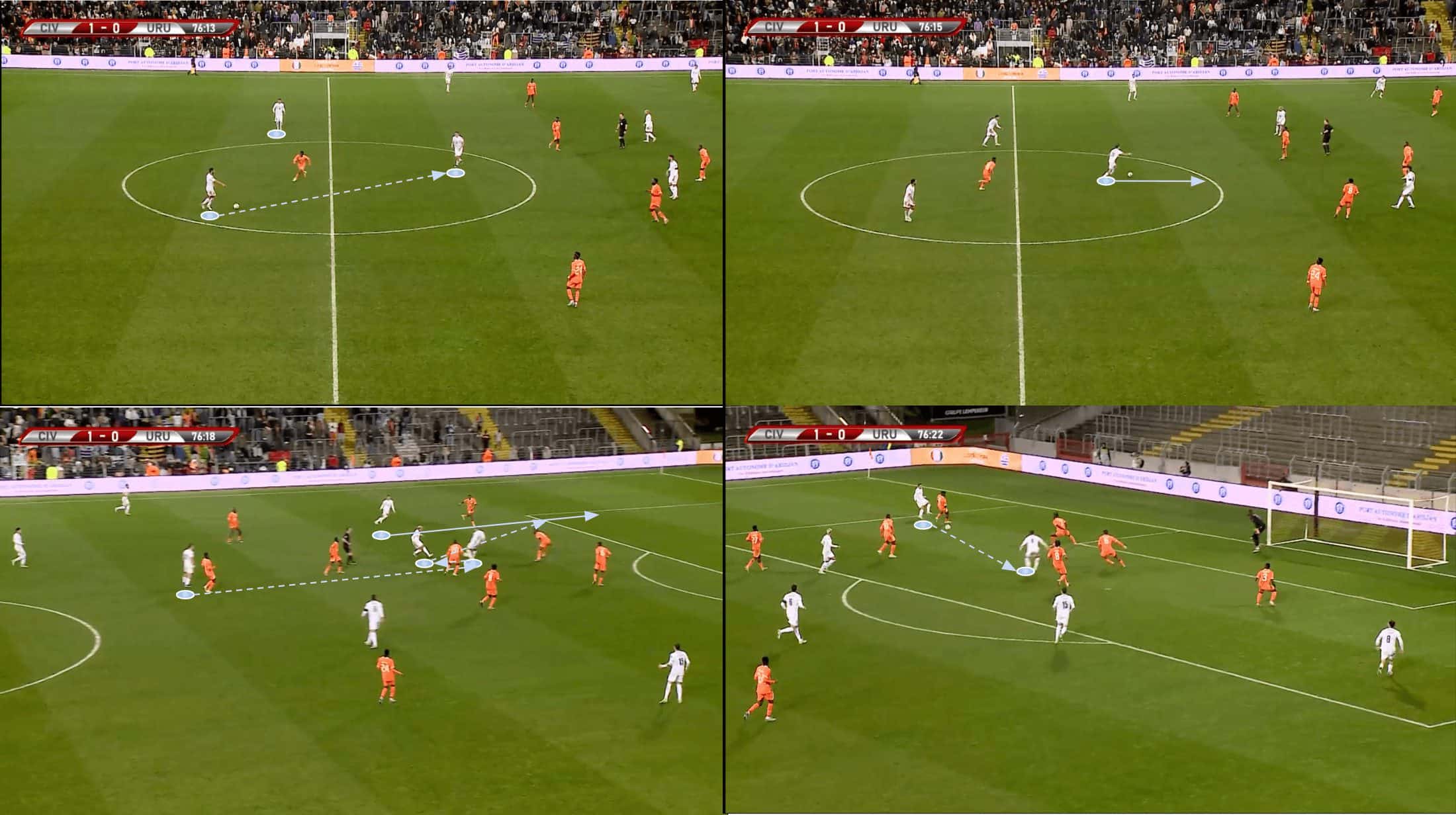
It’s common to find Uruguay building through their centre-backs, who will typically try to progress through the centre of the park when possible, though they’ll have to be creative in forging the necessary passing angles to do that, with the opposition likely to be trying to protect the centre like their lives depend on it.
We see an example of Bielsa’s side moving from centre-back to central midfield and on into a half-space combination between striker, midfielder and winger to enter the opposition’s penalty box in figure 4 — a textbook example of how Bielsa will want to see his side attacking, when possible, in Copa América.
This attack shown above exemplifies, in a nutshell, how the legendary coach will set his team up to open their opponents — right down to the cutback ball from the winger to the striker in the bottom-right image.
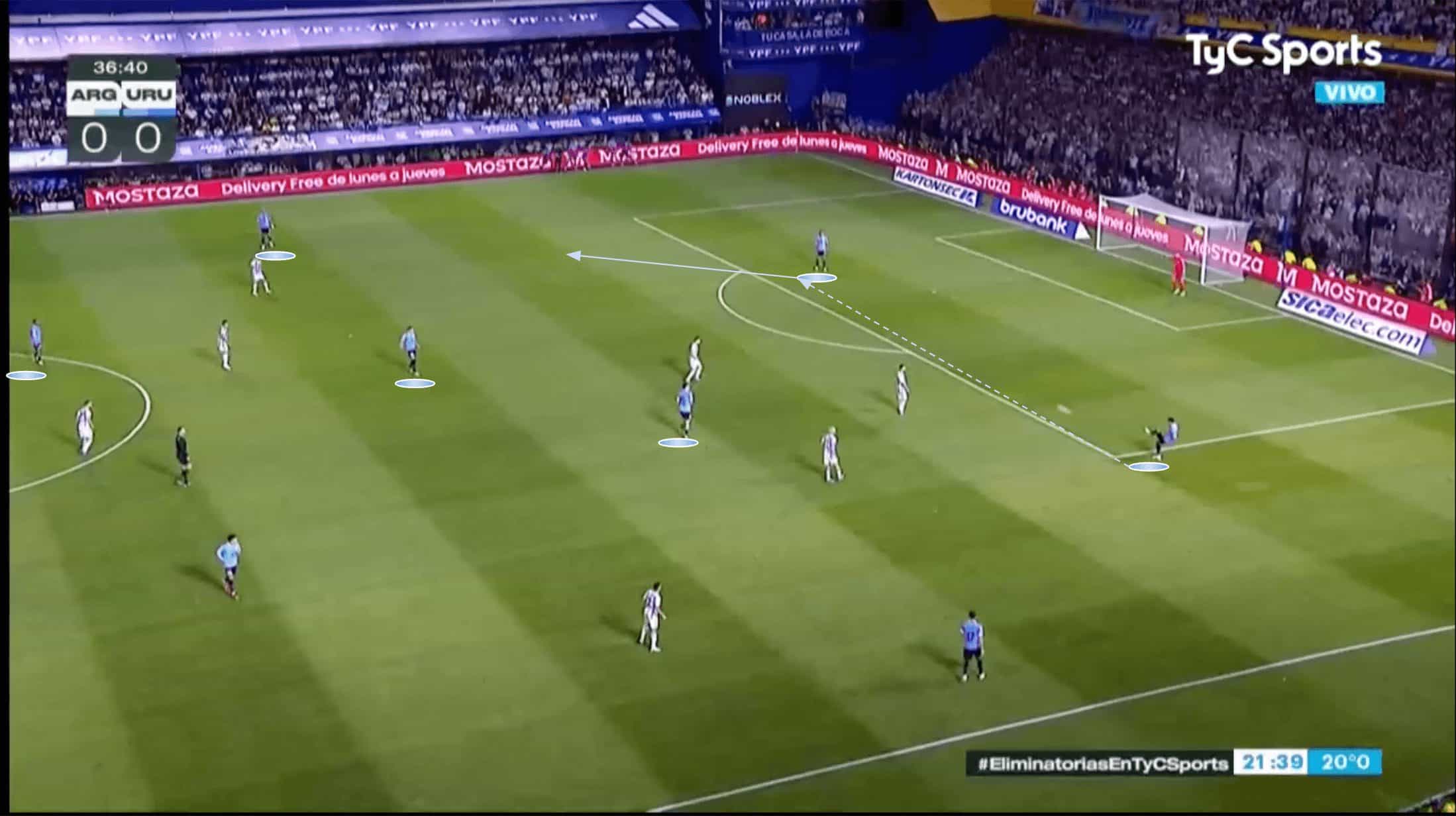
Expect to see Bielsa’s side drop bodies deep to overload the opposition’s forward line when building out from the back, and be prepared for some short passing along the backline as Uruguay try to manipulate the opposition’s press and forge open some ball progression opportunities.
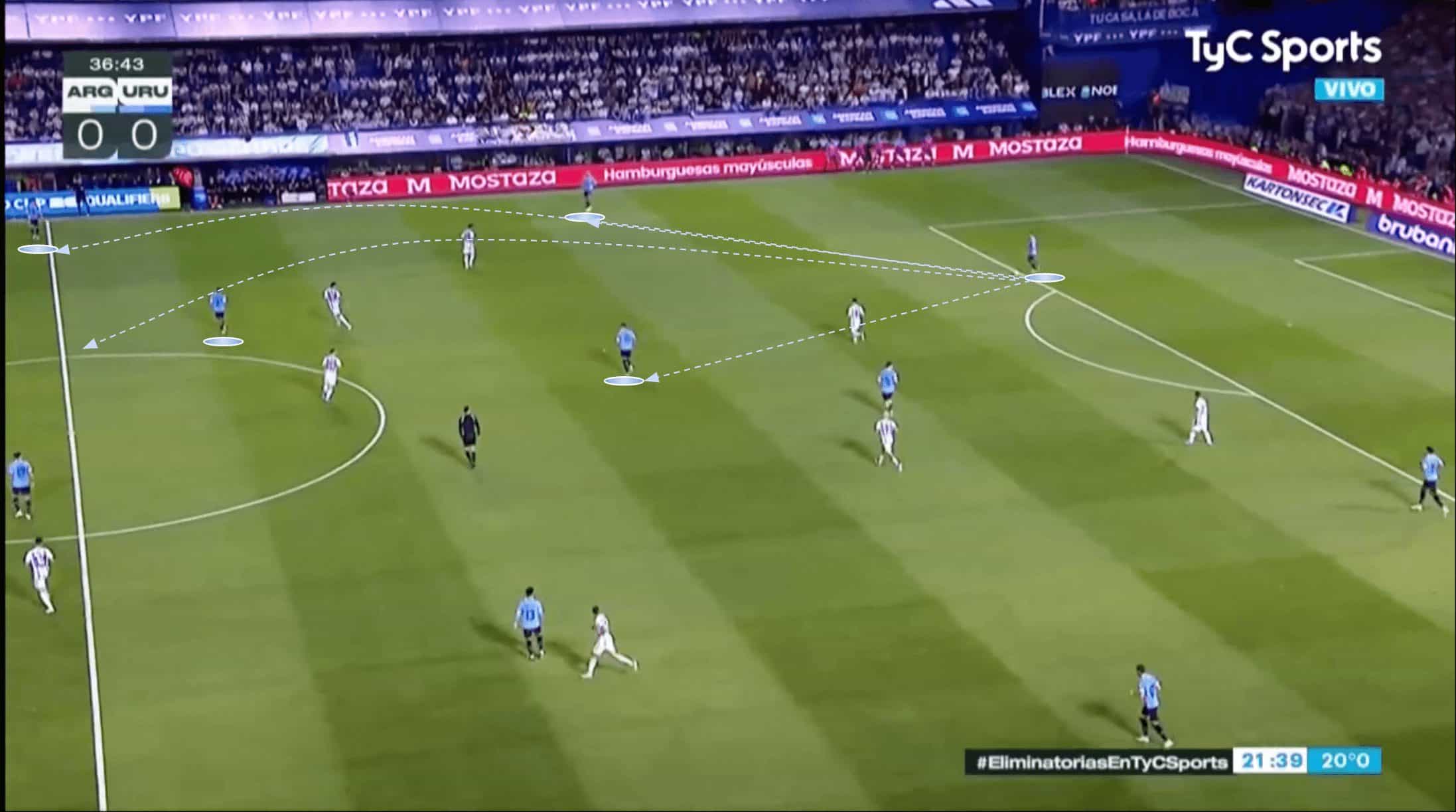
Here, in figures 5 and 6, we see Uruguay drawing some pressure to the left centre-back before switching to the right, where some space had opened up for the right centre-back to carry forward, get his head up and look for ball progression options.
Again, where possible, Uruguay will try to play through the middle from here but expect that to be made difficult by the opposition’s defensive structure a lot of the time.
As such, there are other options to watch out for, including long balls into the channels for Uruguay’s pacey wide men to try and exploit — we see the right centre-back’s options highlighted on figure 6.
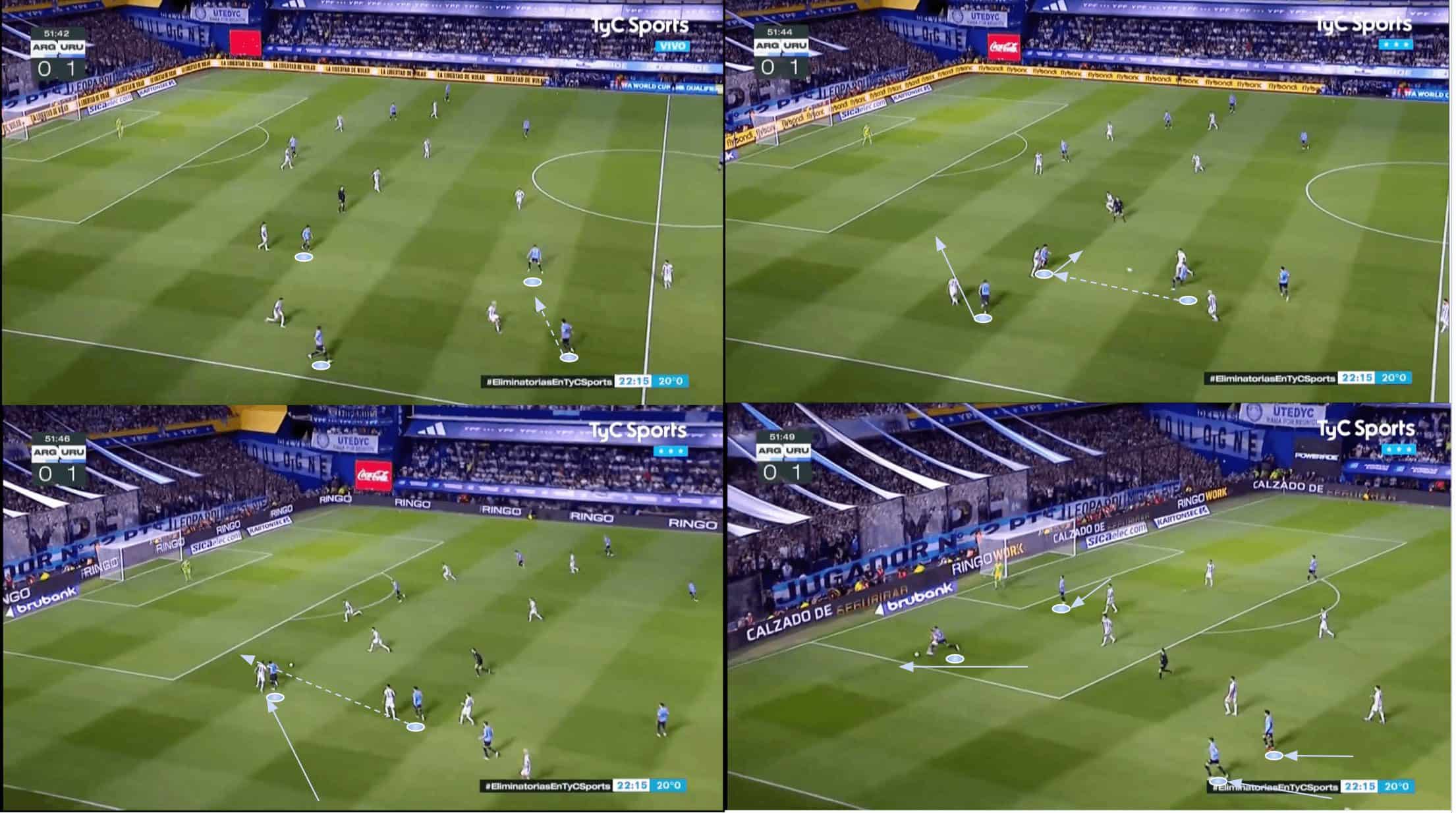
Regardless of whether they’re playing through the centre or wider areas, it’ll be imperative for Bielsa that his further forward players move around to find space and provide options for the ball carrier at all times.
When forced wider, prepare to see plenty of wide diamonds forming, as we also see in figure 7, facilitating the creation of half-space combinations like we also saw back in figure 4; combinations in these areas will be vital for Uruguay in the chance creation phase at Copa América.
Defensive phase
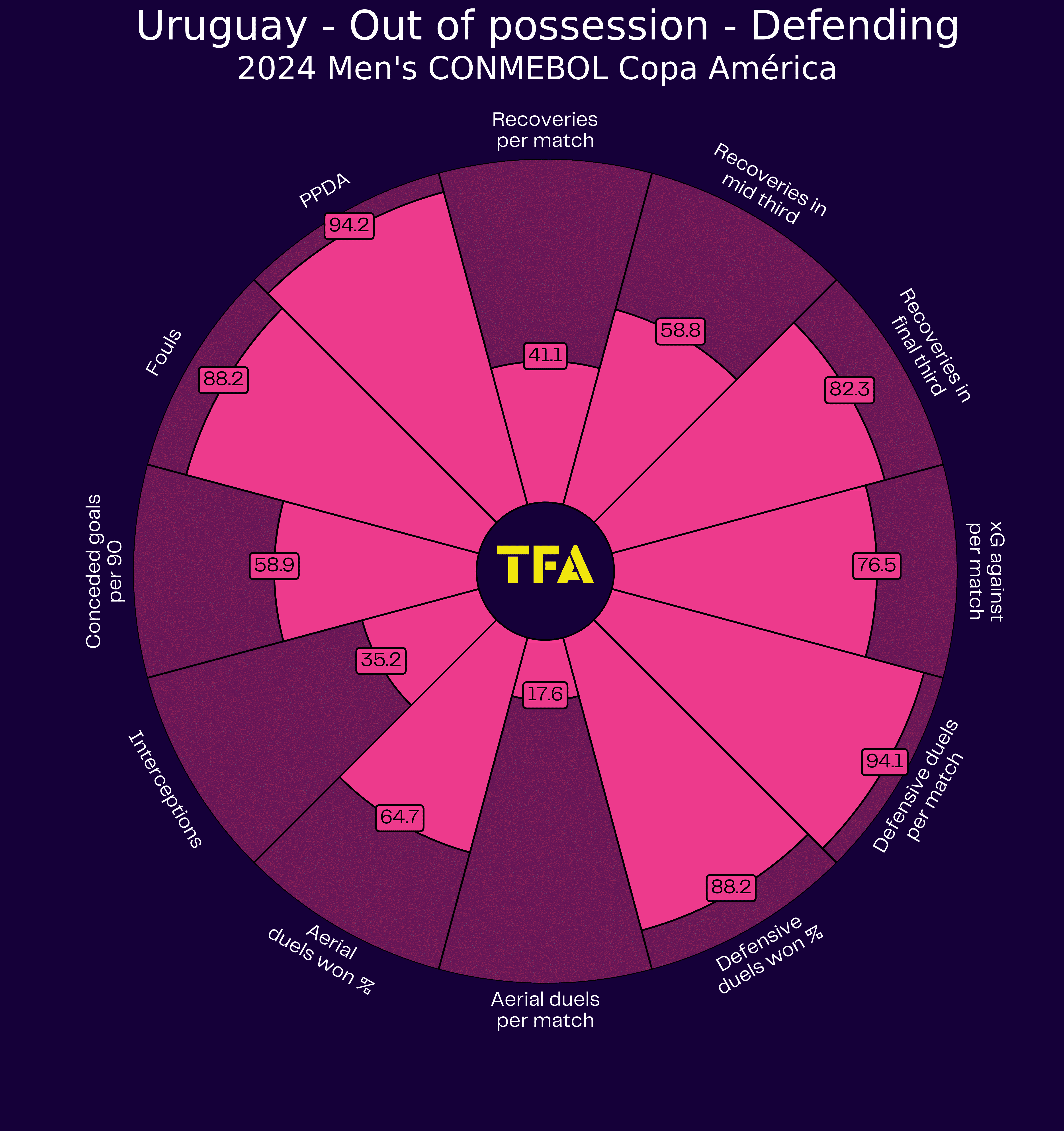
Moving on to Bielsa’s side out of possession, figure 8 displays another pizza chart — this time comparing Uruguay’s performance in several key defensive metrics with that of their Copa América rivals over the last calendar year.
The high percentile rank in PPDA (94.2) means their PPDA is relatively low compared to that of their competition, a key indicator that their pressing intensity tends to be higher than that of their Copa América opponents.
They engage in a lot of defensive duels per game and complete a relatively high number of recoveries inside the final third in comparison with their rivals.
All in all, a major takeaway from this data is that — as you might suspect with a Marcelo Bielsa side — we can expect Uruguay to be one of the more intense teams without possession at this summer’s Copa América.
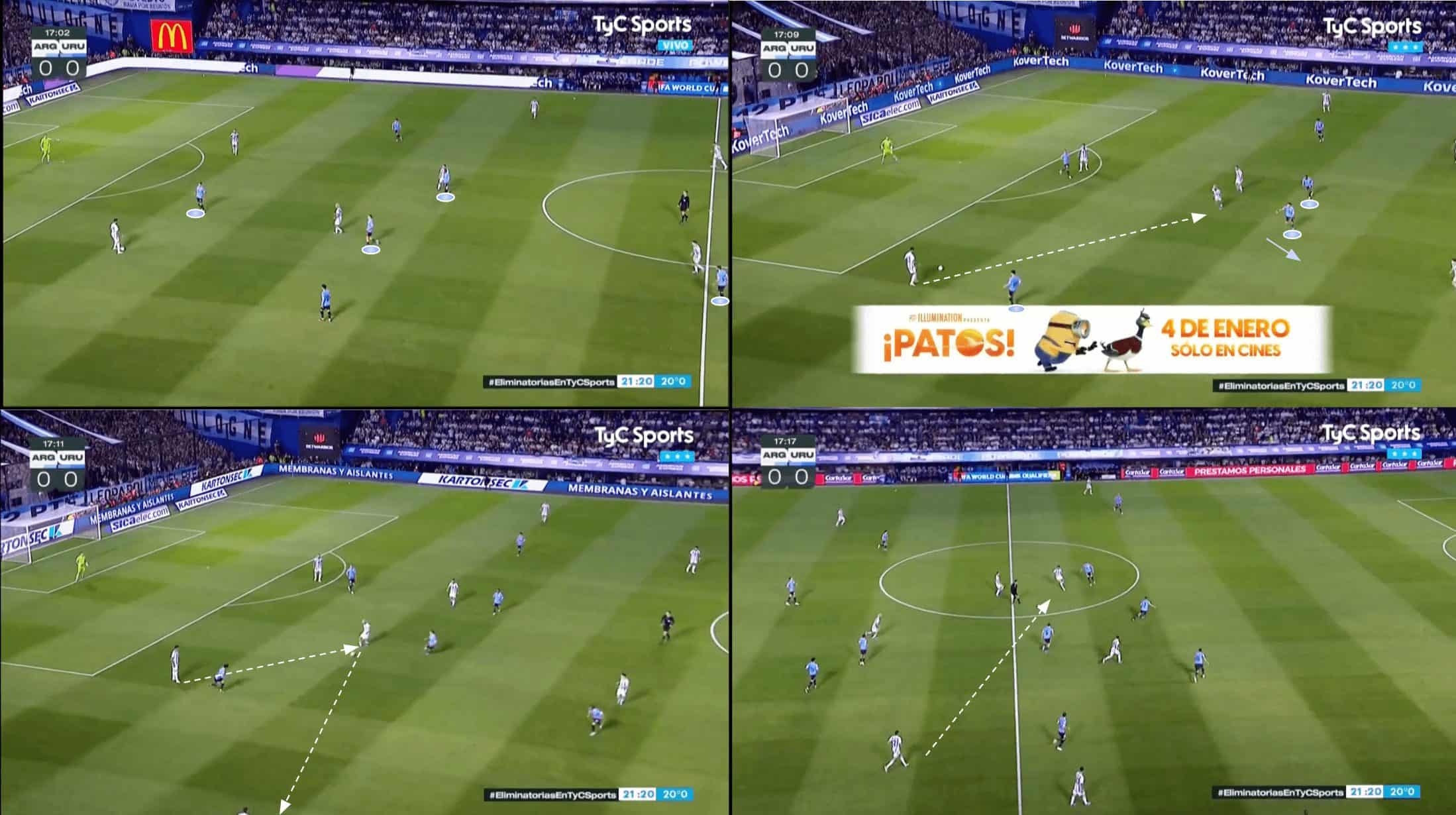
Uruguay’s centre-forward will try to cut the pitch in half and press one centre-back while keeping the other in his cover shadow.
The wingers, and especially the central midfielders, will mark their counterparts quite tightly, prepared to press aggressively in the middle third of the pitch.
This will open up space behind at times, as those players they’re tightly marking drop for other opponents to potentially drift into and exploit.
Uruguay’s midfielders may drop off the deeper player to pick up the more advanced one in space, as we see the left central midfielder doing in the top-right image above.
However, they must be careful to coordinate switching the marking duties on the deeper player as in this case, as soon as the left central midfielder began dropping off, that created a free option for the opponent in the middle of the park whom they could play through and ultimately progress into Uruguay’s half, creating a chance to attack La Celeste’s backline.
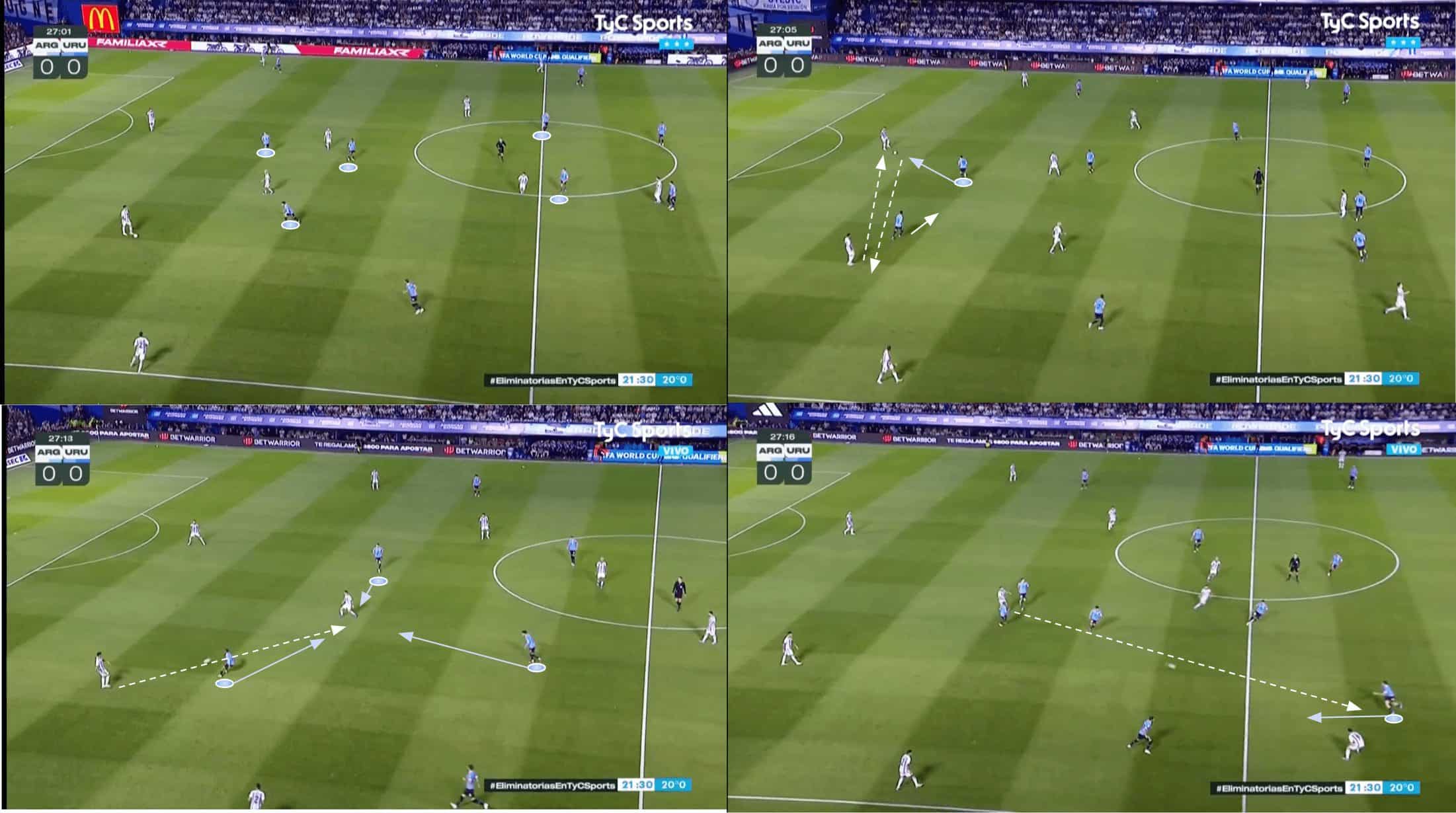
At times, players will find some space against Uruguay naturally due to the way in which their switching works and the intense nature of their pressing.
Players further from the ball carrier will be deemed less of a priority at times in favour of picking up a closer threat.
However, Uruguay’s press will be intense, and it won’t take them long to close down players if they do receive in space.
They’re also likely to set up some central pressing traps at times, baiting the opponent into ‘finding a free man’ in the middle of the park, as we see in the bottom-left image above.
Only to be closed in on from all angles and either directly dispossessed or rushed into their next move, as was the case on this occasion, allowing La Celeste to regain possession as a result of the poorly executed, rushed maneuver.
Ultimately, time and space will be at a premium against Uruguay in the middle of the park — expect Bielsa’s side to be well versed in their out-of-possession organisation and general fitness with intensity levels set to be sky high.
Transitions
As referenced earlier, we can anticipate Bielsa’s Uruguay to be quite effective in transitional phases, with fairly direct attacking with incisive passing not a problem for this team.
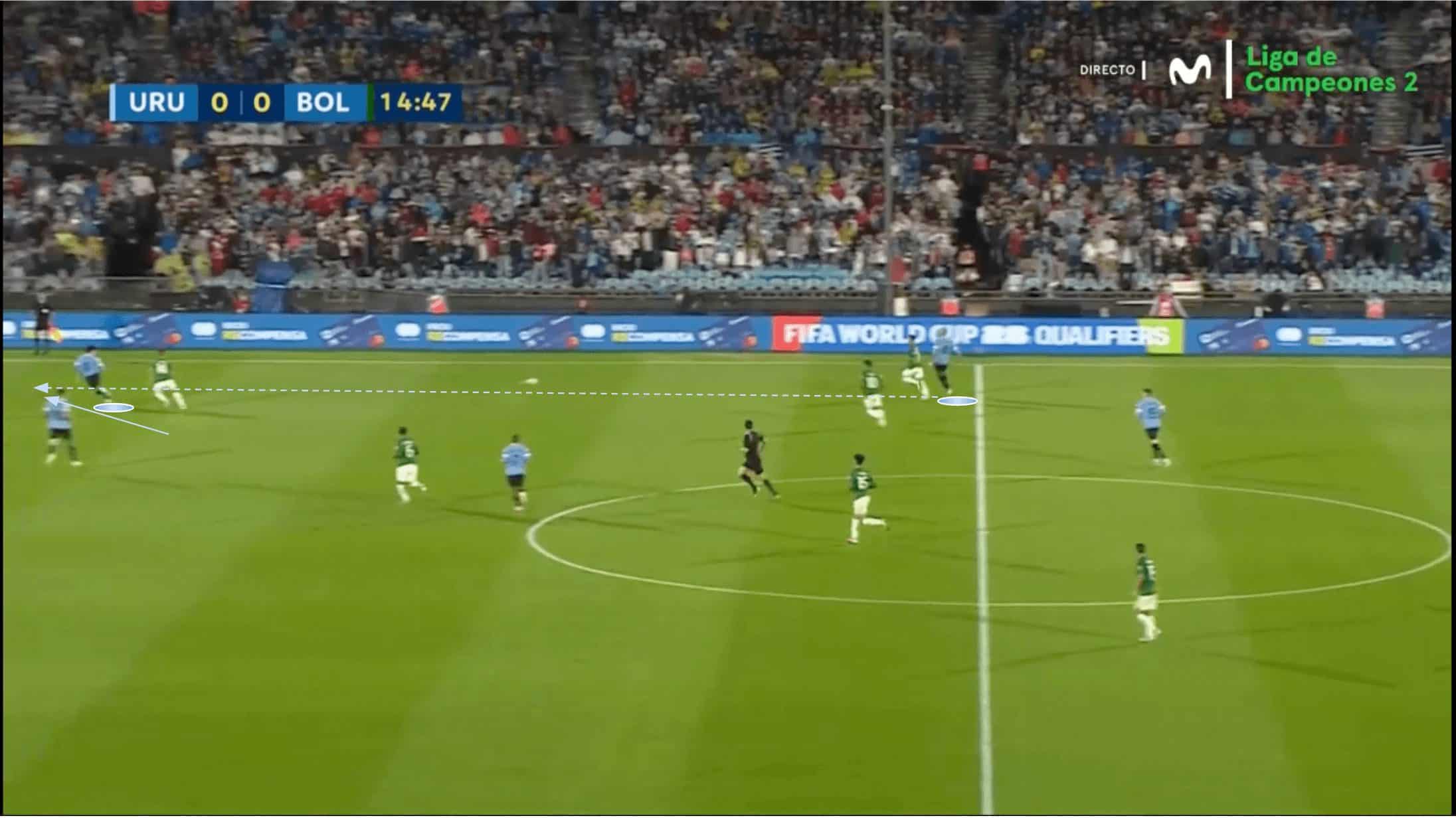
The type of ball we see above in figure 11 will not be uncommon from Uruguay in settled possession phases and especially on the counter as Uruguay seek to exploit the pace of their wide men to attack space in behind their opponents as they did against Bolivia on this occasion.
In addition to Pellistri and Maximiliano Araújo, who we’ve got in the starting XI for La Celeste, we expect the likes of Cristian Olivera, Brian Rodríguez, Agustín Canobbio and Luciano Rodríguez — the latter of whom we feel could have a breakout tournament this summer if given the time to showcase what he can do — to be part of Bielsa’s squad and offer plenty of electricity out wide whether starting or coming in off the bench which could be best exploited in transition.
They will certainly give Uruguay’s centre-backs, full-backs and midfielders valuable options in settled possession and on the counter with the types of pass and run we can see an example of in figure 11 most definitely in their wheelhouse.
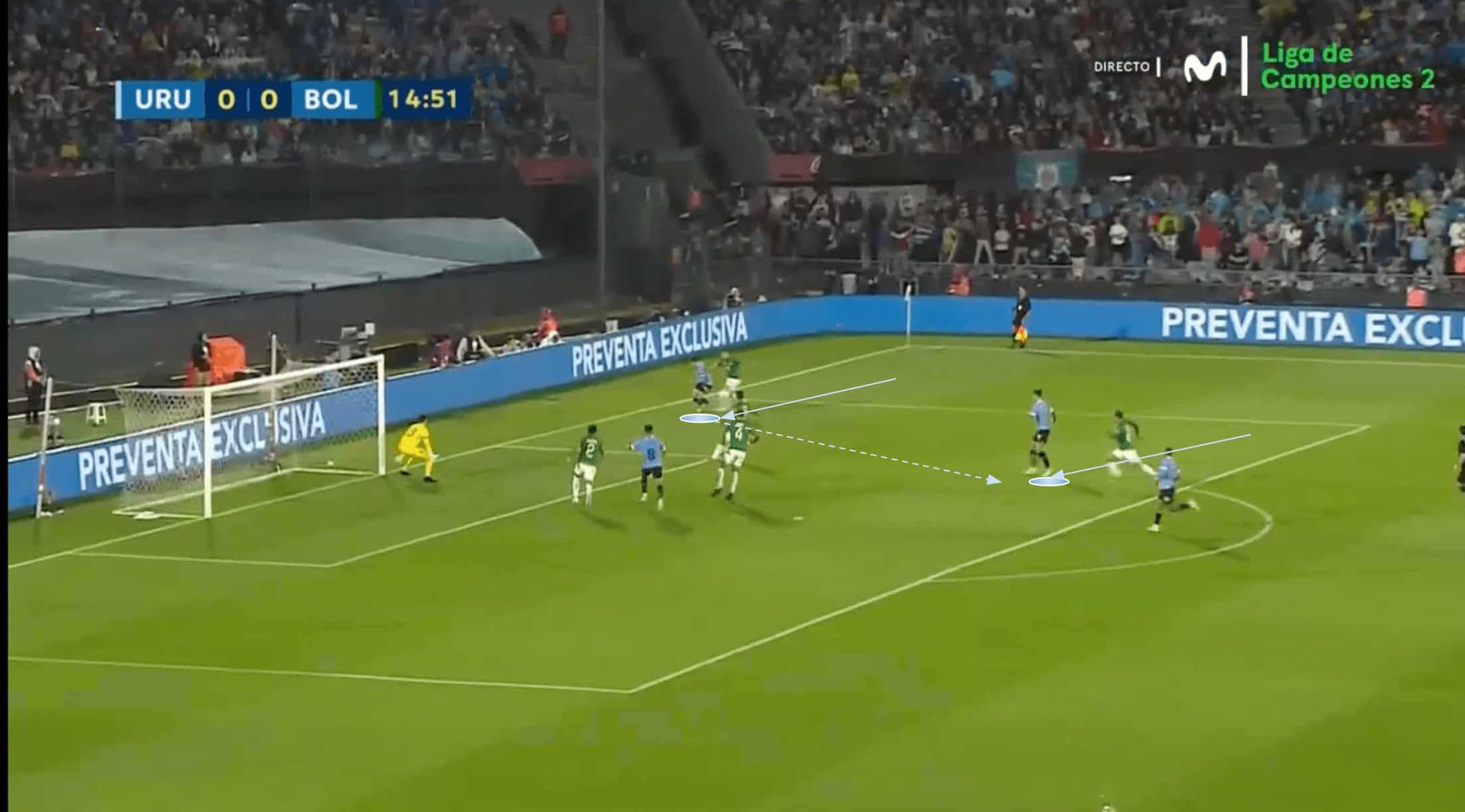
As the play in Figure 11 progressed, we saw Uruguay set up another cutback ball into a dangerous goalscoring position.
This is the most common way Bielsa’s team creates shots.
We’ll see them attempt to create chances via these means quite a lot this summer, and all going well for them, they’ll score plenty of goals through these moves, too.
Transitional attacks can allow the wide man space to drive into which could prove highly effective at generating these types of chances in Copa América.
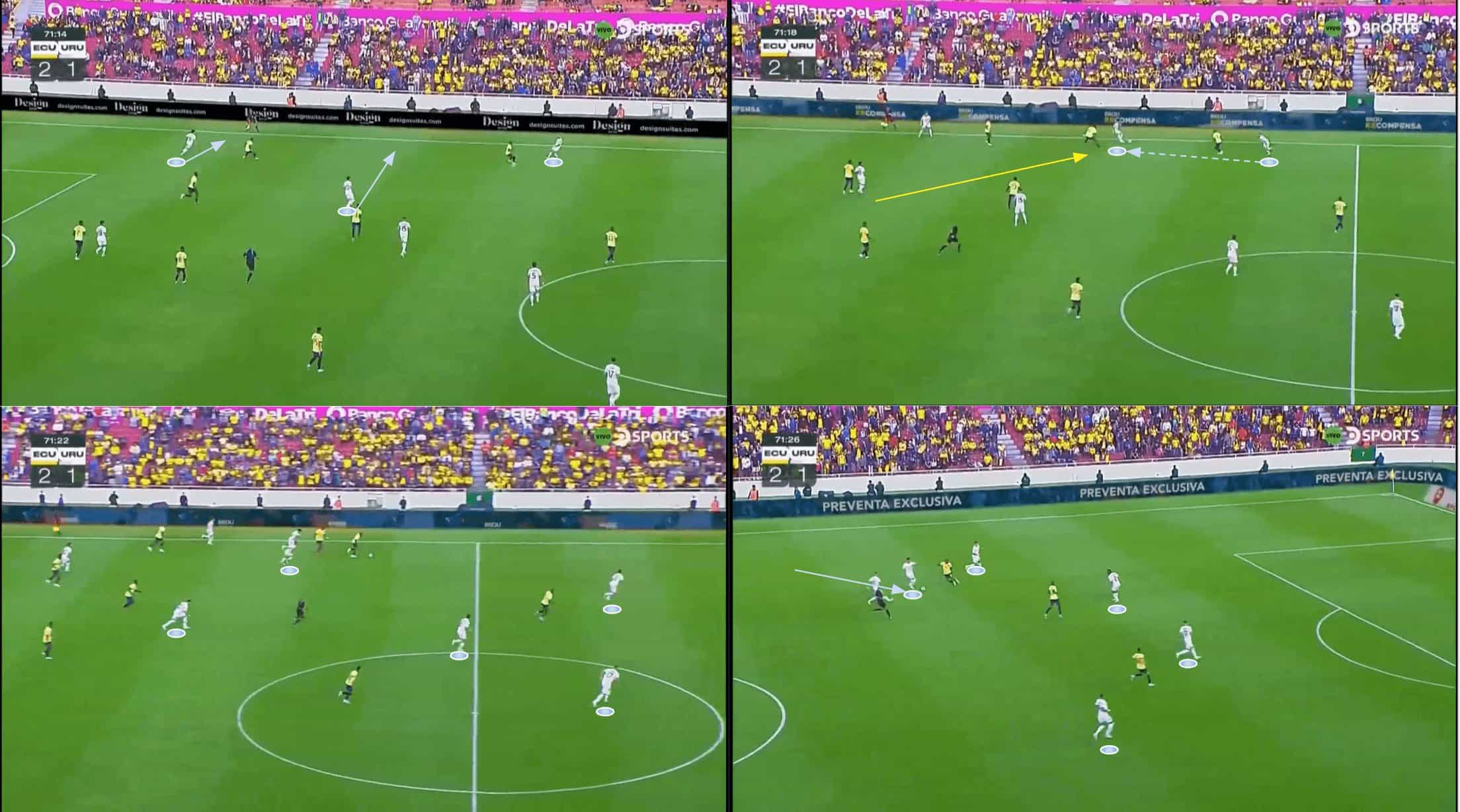
When it comes to transitional defence, expect a lot of counterpressing from Bielsa’s side as they attempt to capitalise on the chaos that occurs in the moments directly preceding a turnover and leverage that chaos as a playmaker.
When attacking, Uruguay will typically have two centre-backs and a holding midfielder—Ugarte—in possession, ready to react should a turnover occur, slowing down the opposition counter and protecting their goal.
They will aim to buy their attackers time to get back and form a more solid defensive structure, like we see in the bottom half of figure 13, where they bought their teammates enough time to get back and regain possession for their side, halting the opposition’s attempted counter.
Again, as you’d expect from a Bielsa team, Uruguay are going to bring the energy to the field this summer and fully commit in possession, out of possession and in transition.
They’re not going to be an easy side to play against, and their youthful nature should play into their hands with such high-energy tactics.
Defenders
Along with the aforementioned quartet of defenders who we predict will start for Bielsa at this summer’s Copa América, we foresee 24-year-old Sebastián Cáceres of Club América, 31-year-old Guillermo Varela of Flamengo, 24-year-old Bruno Méndez of LaLiga side Granada and 29-year-old Lucas Olaza of Krasnodar making the trip to Copa América for Bielsa this summer.
Cáceres offers quality cover at centre-back, as does Bruno Méndez, who can also provide some cover at right-back if needed.
The primary cover at right-back comes in the form of Flamengo’s Varela, who’s also got some experience playing on the left.
This is where we primarily expect Olaza to be useful as an extra set of legs to Viña and Maximiliano Araújo, who could also be deployed deeper as additional cover in the back four.
Versatility is always handy in a tournament squad, hence why this is emphasised in our predicted starting XI and subs for the backline.
Midfielders
Ugarte, Valverde, and De La Cruz have recently established themselves as formidable central midfield trio for Uruguay, and we don’t anticipate seeing them break up much in this tournament.
However, that said, La Celeste are not short of options in the middle of the park.
Tottenham Hotspur’s Rodrigo Bentancur is another option who can play a variety of different central midfield roles depending on what Bielsa needs—expect to see him feature in some capacity in the tournament.
Nahitan Nández will also likely travel.
The Cagliari midfielder is also capable of providing cover in the backline if needed, having featured at right-back for La Celeste in recent times.
Giorgian de Arrascaeta, also of Brazilian giants Flamengo, should make the trip and can provide an offensive midfield option as well as another left-wing option.
Lastly, Lazio’s Matías Vecino will probably make the trip as Bielsa’s backup to Ugarte in defensive midfield.
These midfield picks provide balance and a large degree of versatility, which the legendary Argentinian coach would value in a tournament setting.
Forwards
We already mentioned many of the attacking options we expect to make the Uruguay squad alongside our predicted starting trio of Pellistri, Maximiliano Araújo and Núñez.
Cristian Olivera, Brian Rodríguez, Agustín Canobbio and Luciano Rodríguez will probably make the squad as wide options, offering different skills to one another and the starting wingers, which Bielsa could feel the need to try out at different times throughout the tournament — all are players who’ll hope to have an even greater role to play for the national team in the future with time ahead of them in their careers; they’ll be hoping to get an opportunity to make their mark on the big stage.
Up front, with Núñez starting, we predict Luis Suárez will also make the trip to the Copa América as a senior squad member for Bielsa, his coaching staff and the players to rely upon for dressing room leadership and, crucially, some on-field quality in small doses.
It’ll be up to the boss and the player himself to manage his minutes appropriately to get the best out of the now-37-year-old forward if he does, indeed, go to Copa América this summer, in what could be his last stand for the national team.
Key Player
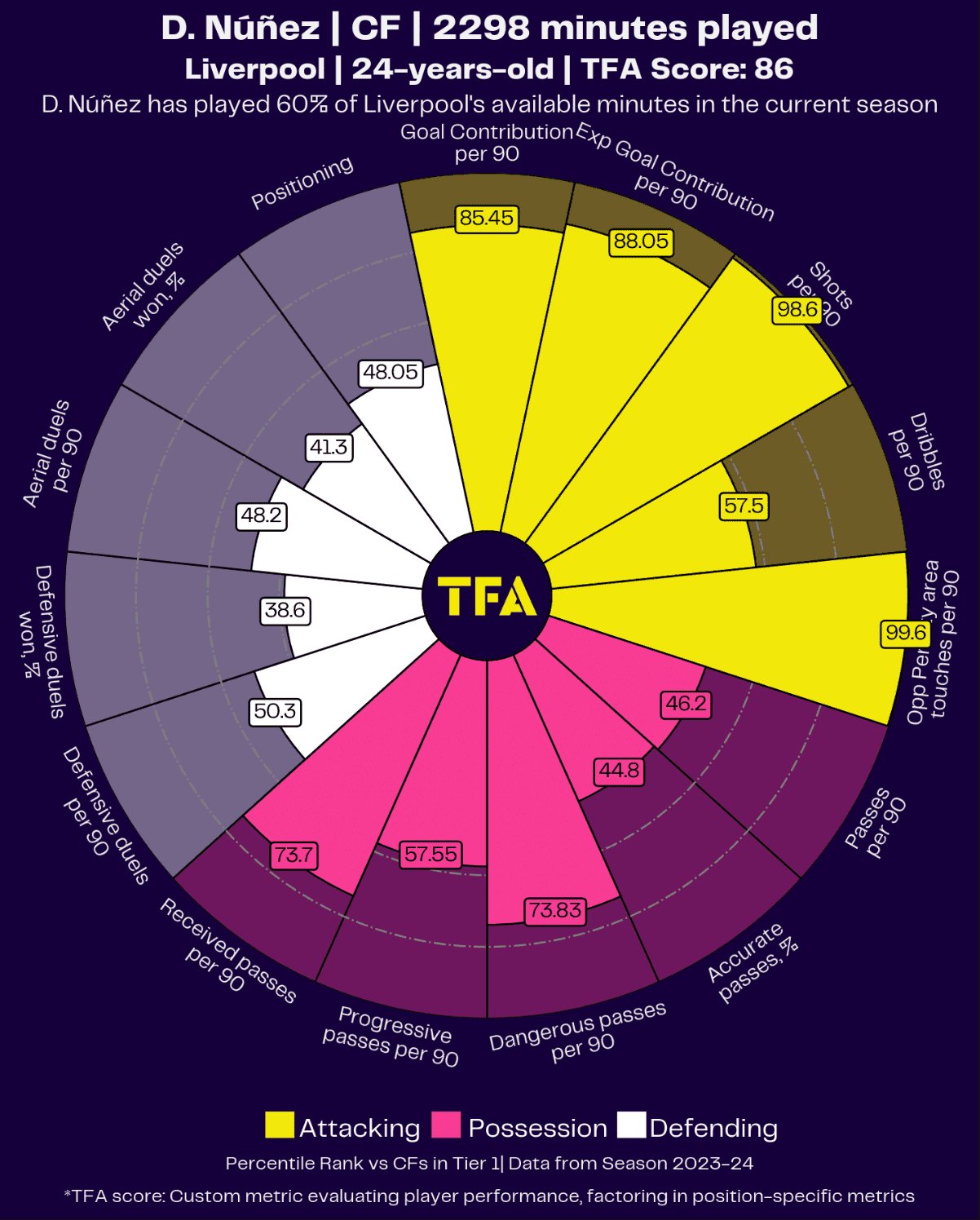
For our key player, we’ve gone for Darwin Núñez of EPL side Liverpool.
Turning our attention to the pizza chart above, which provides Núñez’s percentile ranks in key metrics across his game from attack to defence to possession compared to other centre-forwards from Europe’s top-five leagues, we can see that the 24-year-old generated a large number of touches inside the opposition’s penalty area, shots, expected goal contributions, and, critically, goal contributions during the 2023/24 campaign.
He could offer more in defence, and Bielsa will probably be hoping to see the best of the striker in that regard this summer, but most of all, the manager will be relying upon Núñez for his offensive qualities — meaning his shot-taking ability but also his movement, positioning and physical qualities all of which make him a formidable presence up front for his team, helping him to generate goalscoring opportunities.
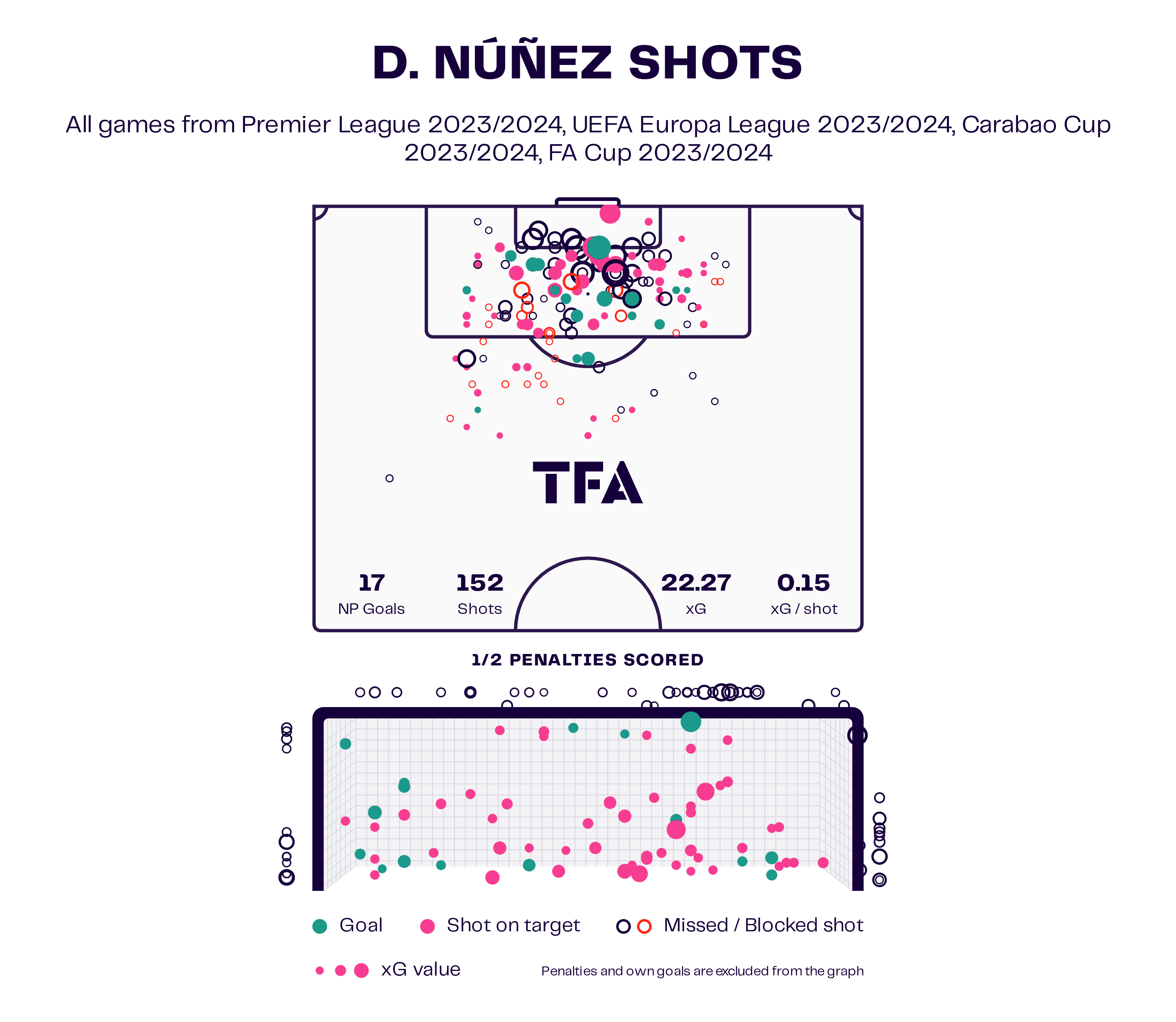
Figure 15 shows Núñez’s shot map from all club competitions in 2023/24 and highlights his 17 non-penalty goals from 22.27 xG — averaging an xG per shot ratio of 0.15.
Núñez’s finishing was not incredible this past season, and it’s definitely an area for improvement, but the attacker is generating a high volume of decent chances through his movement and positioning, which will be important for Uruguay in the chance creation phase this summer.
They’ll be hoping the 24-year-old’s goalscoring form picks up to match his movement, as this could propel Uruguay all the way to the trophy.
Tournament prediction
Uruguay don’t enter this tournament as favourites, but they aren’t far off.
Indeed, Brazil and Argentina come to the 2024 Copa América with greater overall quality, but La Celeste aren’t far behind them in that regard and if they can put their different components together more smoothly than their biggest continental foes, that could make up the gap in quality between them and the big two, making for a very interesting knockout stage.
We see Uruguay as third-best entering the tournament, so we can’t really predict anything beyond the semi-finals at best, but they’re very much in with a shout of going all the way.
What’s for sure is that they should aim to push past the quarter-finals for the first time since 2011, when they emerged from the tournament as champions the last time.

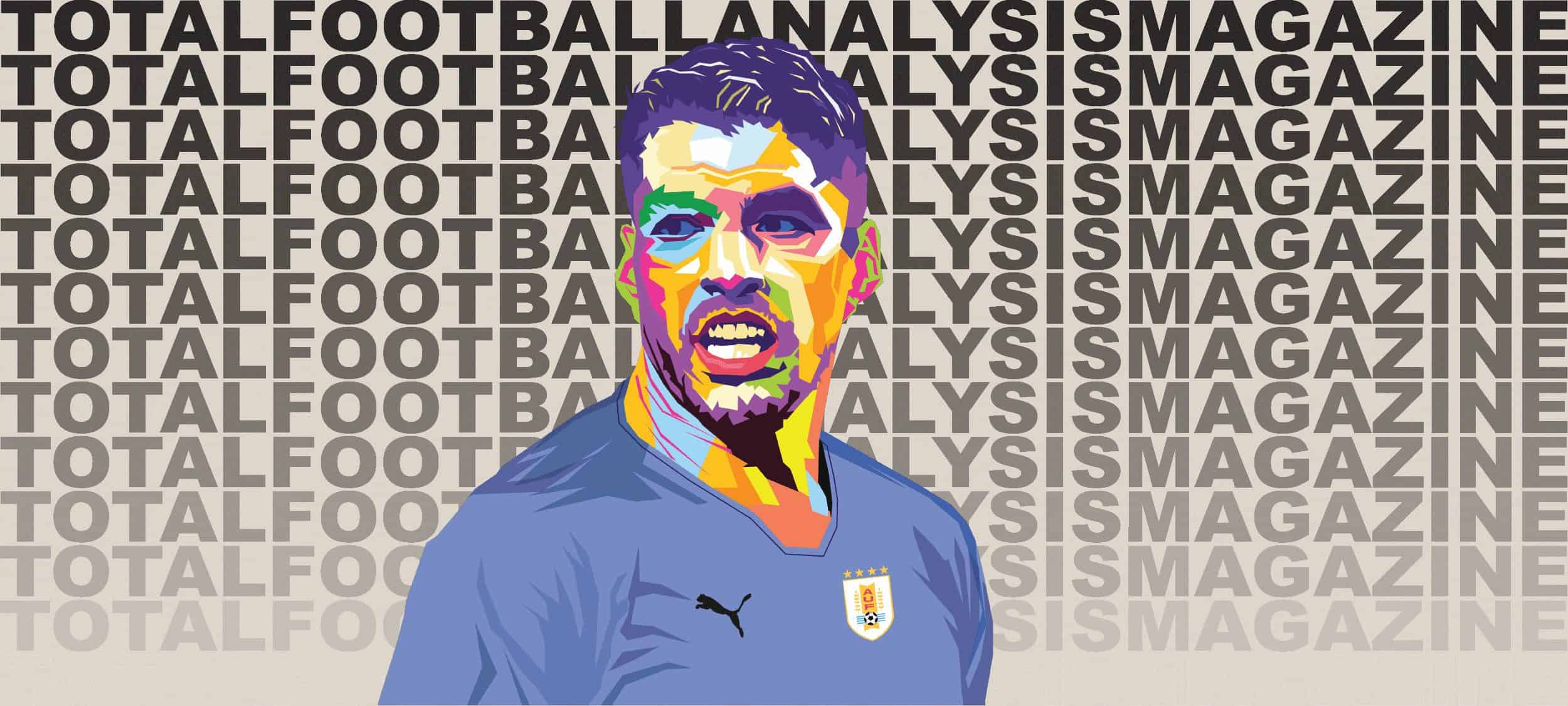



Comments